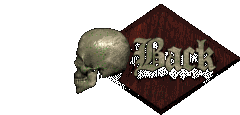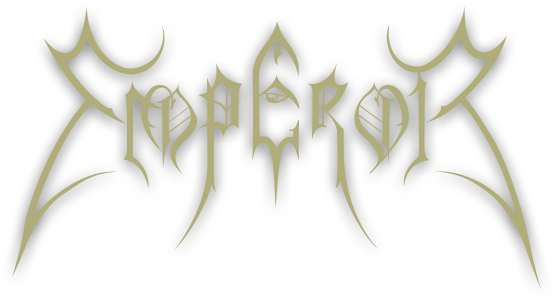
'In the Nightside Eclipse'
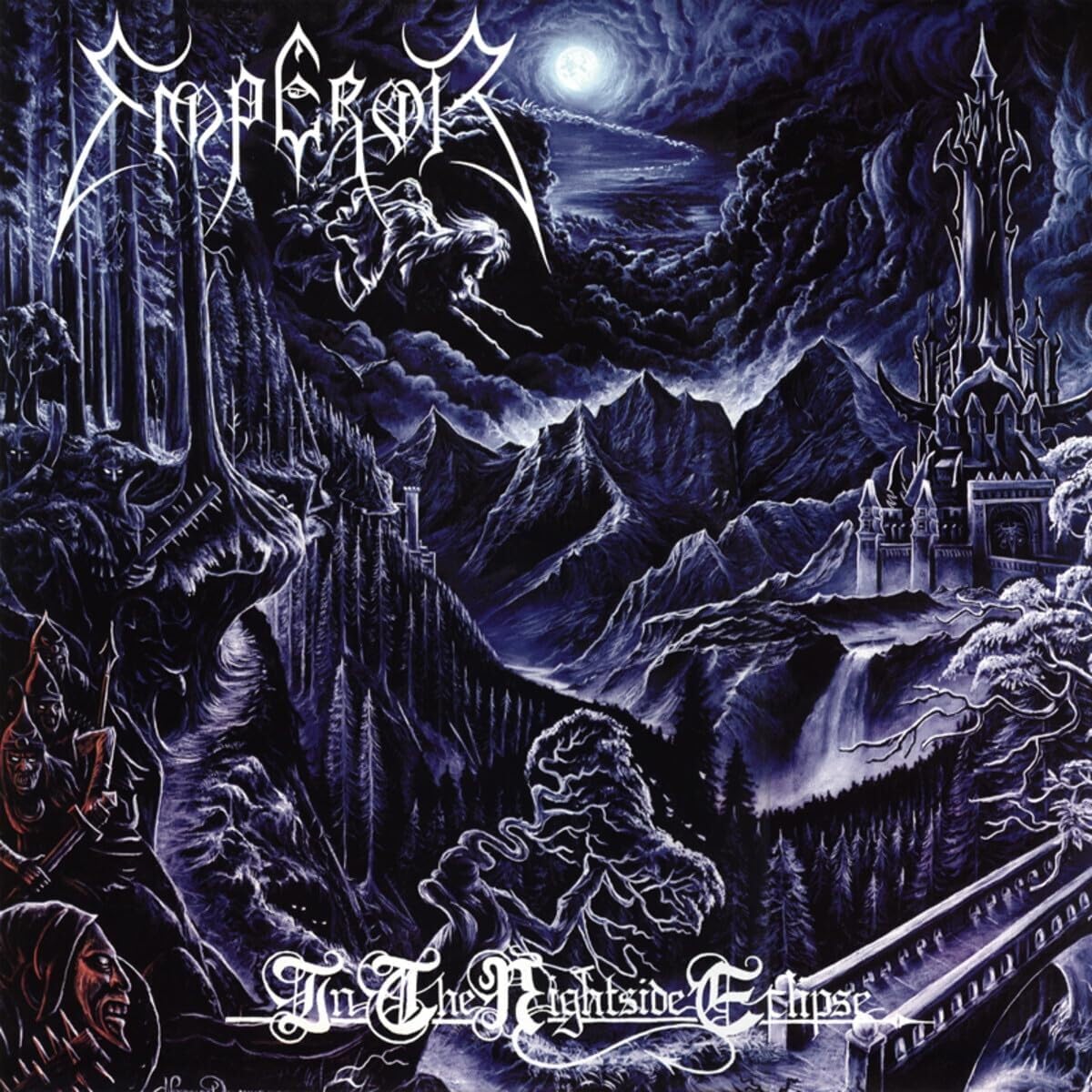
(First released on
Candlelight records in 1994, then reissued in gatefold cardboard sleeve
in 2014 )
MARK:
89/100
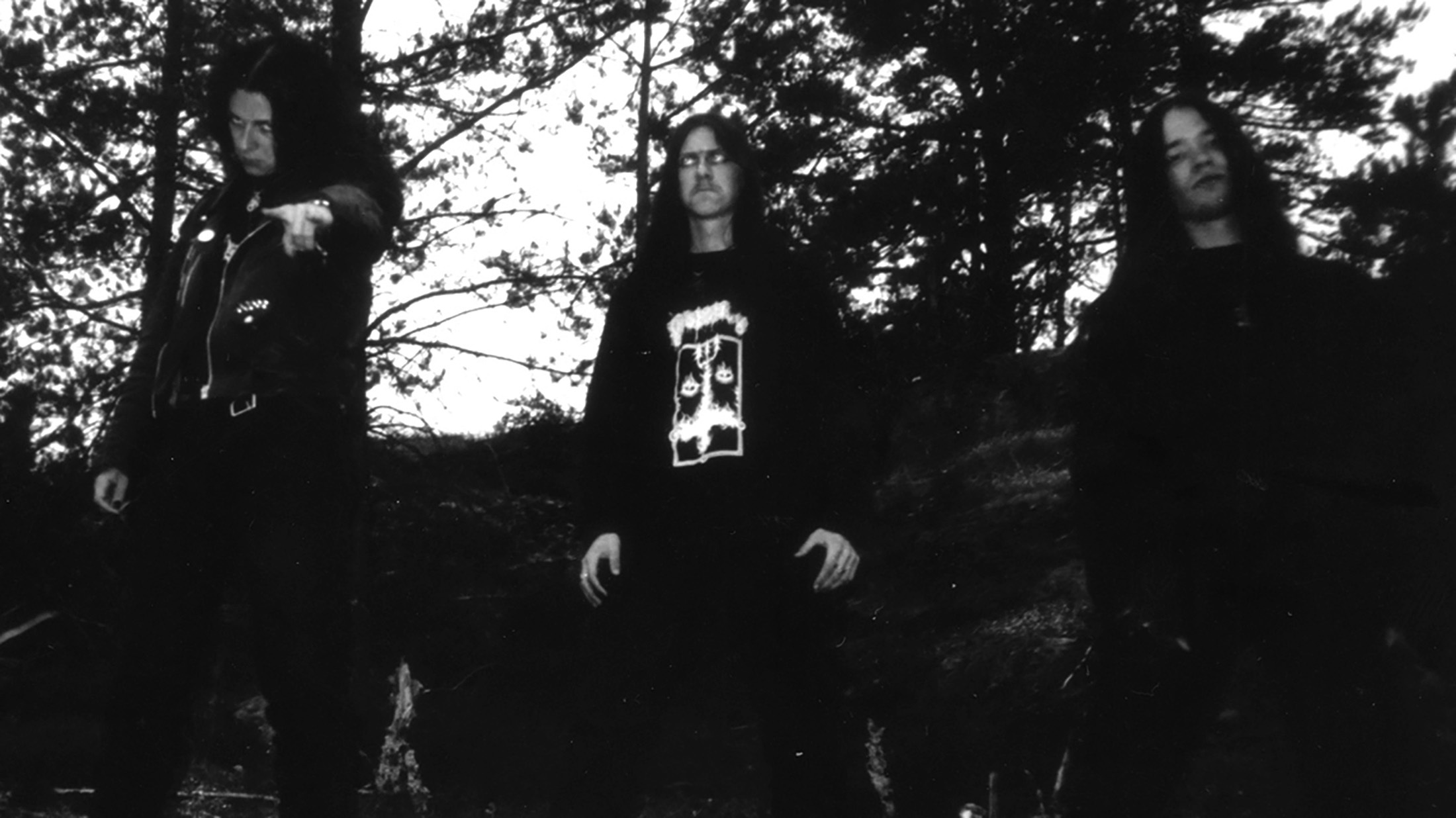
Prologue
1993 and 1994 were pivotal years for releases of the second wave of Black Metal. Dissection, Darkthrone, Burzum, Immortal, Marduk released key albums during the former, whereas 1994 was the year for Mayhem's "De Mysteriis Dom Sathanas", Darhthrone's "Transilvanian Hunger", Burzum's "Hvis lyset tar oss", Satyricon's "The Shadowthrone", Gorgoroth's "Pentagram".
Emperor's debut album covers both of the years: it was recorded in 1993, mixed and released in 1994, and like all the other cited records it has its own distinctive traits that make it distinguishable. It is probably the first consciously composed album of Symphonic Black Metal due to the heavy use of synthesizers within a glacial, mysterious, sometimes weird, sometimes progressive musical framework.
Package version and other versions available
The item object of this review is a 2014 remastered reissue in a slim gatefold cardboard sleeve containing only 1 CD and a 16-page booklet. There are 12 tracks as the songs of the limited EP "As the Shadows Rise" are included here. This vinyl can be found on sale currently for over US$ 250.
More than 50 other versions exist, and the more recent ones contain 2 CDs, one of which has an alternative mix of the album.
However, due to the really amazing front cover artwork, this album needs to be owned in vinyl, too.
Visual aspect
The front cover artwork of the digipack was made by Necrolord, a person who really knows how to draw and paint. We are light years away from most lame AI artworks that we can see in this decade.
This piece of art is constituted by a drawing on black paper with white, blue and red pastels and seems inspired by "The Lord of the Rings" when it was not in fashion, and was decidedly conceived to appear on a vinyl.
Necrolord also made the artworks for Grotesque's "Incantation" mini-LP and Dissection's "The Somberlain".
An ex-girlfriend of Samoth drew a sketch of the tower and then the death rider from the EP and together with other ideas they were all sent to Necrolord for his work.
The band's logo, in white like the album title, was placed high and on top of that sits the moon surrounded by beautiful clouds.
On the left of the logo the Grim Reaper is arriving on a horse while holding a scythe. This detail already appeared on the previous EP and is a tribute to Gustave Dore's popular ominous and apocalyptical 1865's engraving "Death on A Pale Horse".
As the Book of Revelation described the Grim Reaper is followed by Hell and other infernal characters.
On the right a medieval/fantasy-like fortress stands out, while on the centre-left is an isolated tower. At the centre of the drawing, in the distance, we can appreciate a breath-taking mountain view.
Most of the left part is occupied by a cliff rich in tall firs, but there are also wicked menacing armed partly red Tolkenian orcs marchng to the Black gate of the castle along a bridge.
Below some glowing eyes belonging to unidentified beings watch the scene carefully. 2 trees are close to the viewer and they are totally different than the firs, they contrast with them, in that they have the shape of some typical Japanese trees. They are all but straight and they don't have a clear, distinct form. Also, some parts of the fortress have a Japanese style reminding some popular late 70's Japanese robots appearing in several cartoons.
Just beneath the fortress springs a waterfall.
The front cover is completed by the title of the album below in the middle.
Inside the digipack we find a photo on 2 pages where the protagonist is the silhouette of a Norwegian hill during a cloudy day at sunset. Some conifers are visible on the left.
The back page displays 4 enframed pictures of the members, the titles of the tracks on this edition, a pentacle under Emperor's logo and a photo showing Satan or another winged monster holding 2 rings in its hands. This photo is called "Demongate" and most likely decorates a mansion or a building.
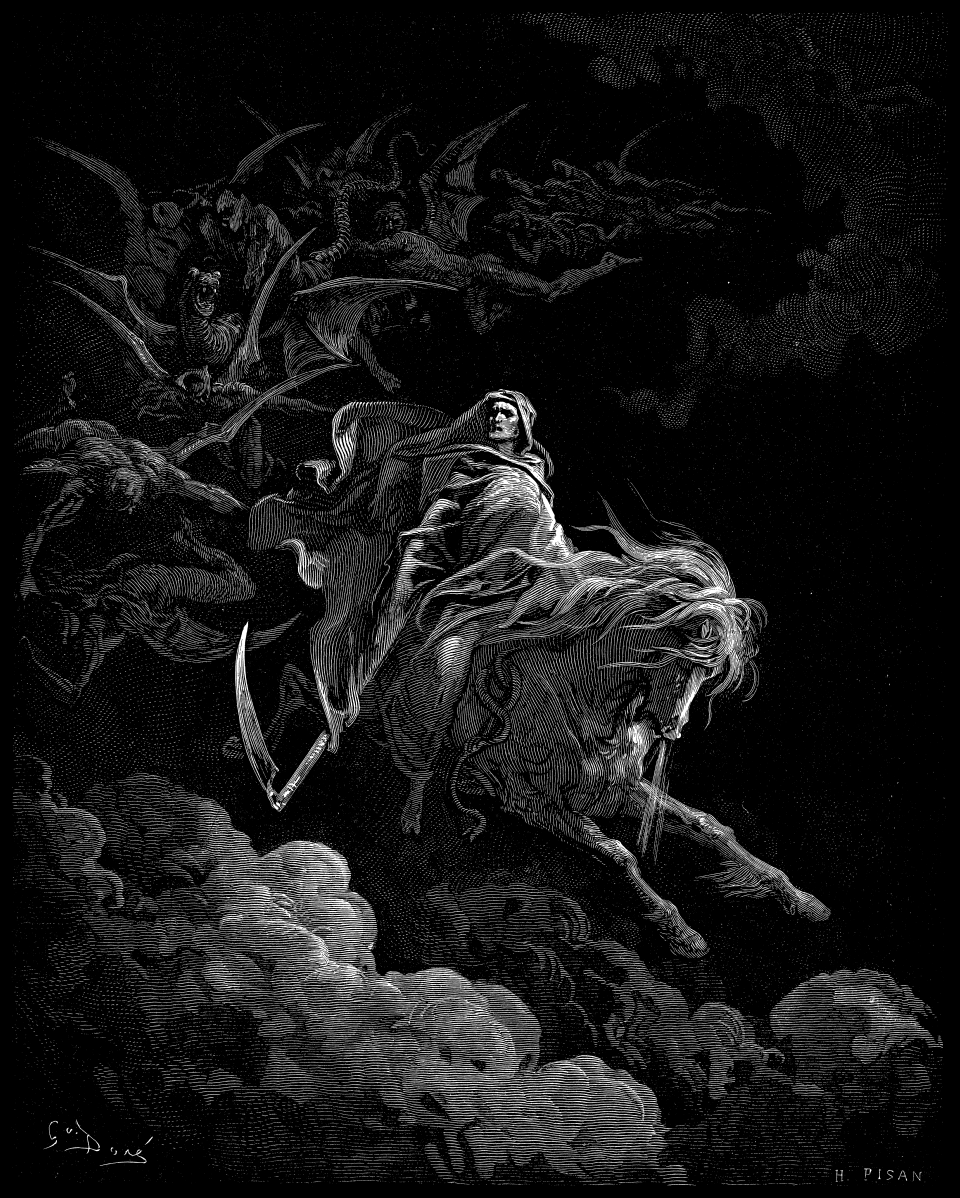
(Gustav Dore_Death on A Pale Horse)
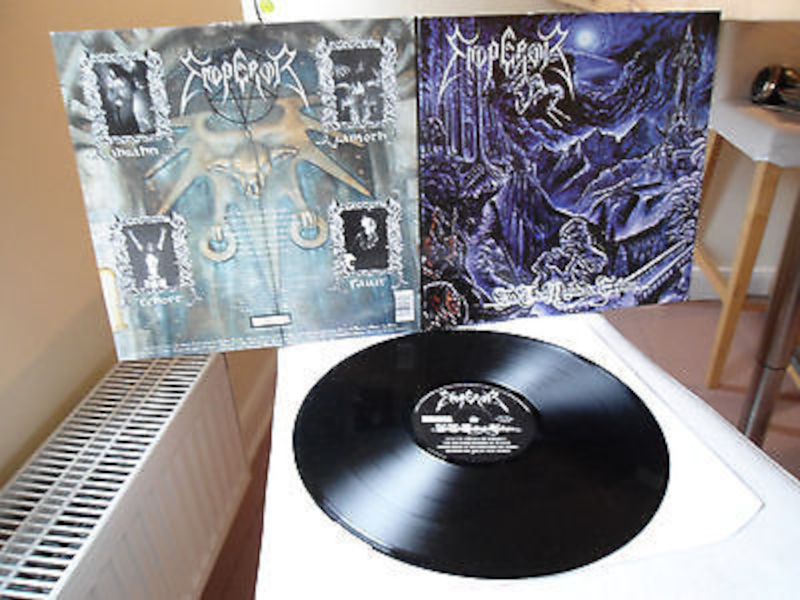
(first vinyl press)
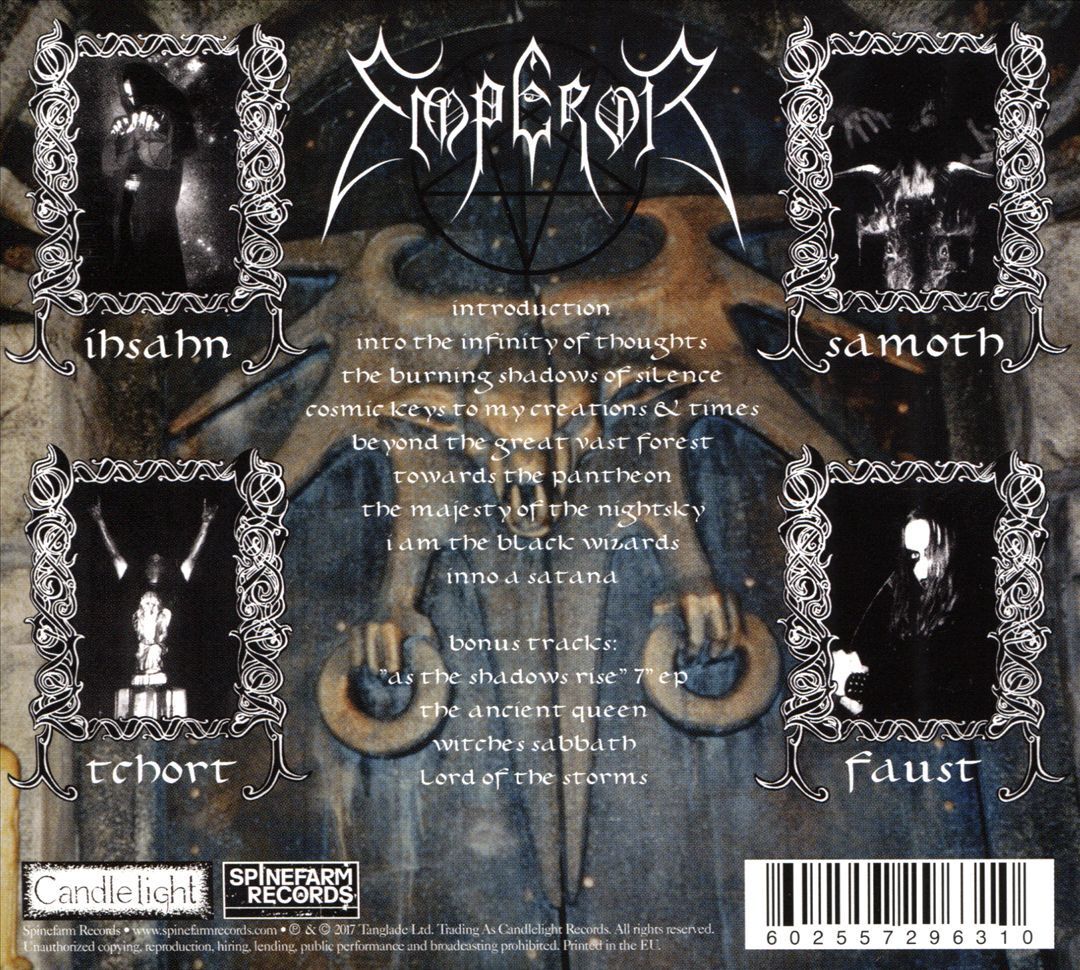
(back cover)
The disc artwork makes it look as if it were etched in a Medieval
pattern and shows a bloody battle between 2 armies in a metallized
reflecting black and white.
The booklet front page is the same as the digipack front cover artwork
with the only difference in the band's logo moved high to the left.
The second page is a collection of handwritten lyrics on different
sheets together with posters and flyers informing about the release of
this album.
Page 3 shows 4 separate photos of the 4 musicians playing on this debut
album.
The next page contains the beginning of the interview about the making
of the record. It first appeared on Decibel Mag.
The fifth page shows a wicked black and white photo of the 4 musicians,
each waving a different weapon.
The interview goes on on the sixth page, whereas the seventh portrays a
colour photo of Emperor on stage, which contrasts with the previous
photos.
Page 8 is destined to the prosecution of the interview, whilst the
ninth includes one more photo in black and white. There is a person or
an undefined being with a long hooded black dress shot from its back
holding a sceptre. Below is a typical foggy Norwegian wild landscape.
The interview ends on page 10, while the eleventh displays a very
special b&w picture of the band. First of all they are only 3, and
secondly 2 of them have ghostly white eyes.
The lyrics of the album start on page 12, while on the page aside there
is a colour photo of one member of the band standing on the top of
a snowy hill during a day when snow was melting at lower altitudes.
The 14th page shows the last 4 lyrics of the album, once again on a
black background.
The photo of the 15th page sees two band members creating a ballfire
through some mouth-blown alcohol or gasoline lighting them on a
pitch-black night.
The last page, which already appeared on the original vinyl, shows the
band logo in black, big and high. Then we see the ruins of a
Transylvanian castle at dawn or sunset. On the lower part of the page
are printed info about the recording of the album and the EP, the
music, lyrics and photo credits, and finally regarding the remastering.

(7" EP front cover artwork)
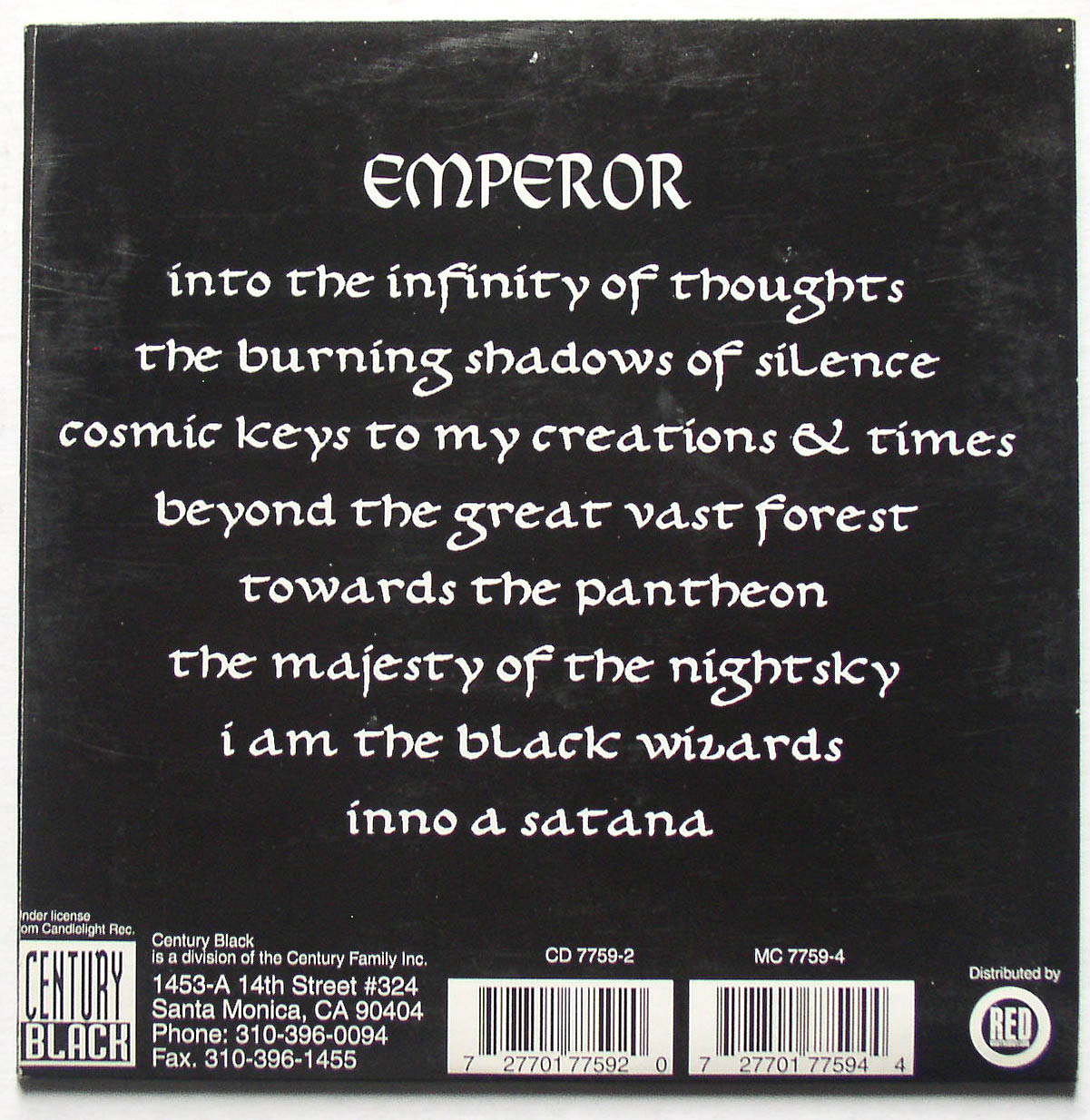
(1994 promo CD)
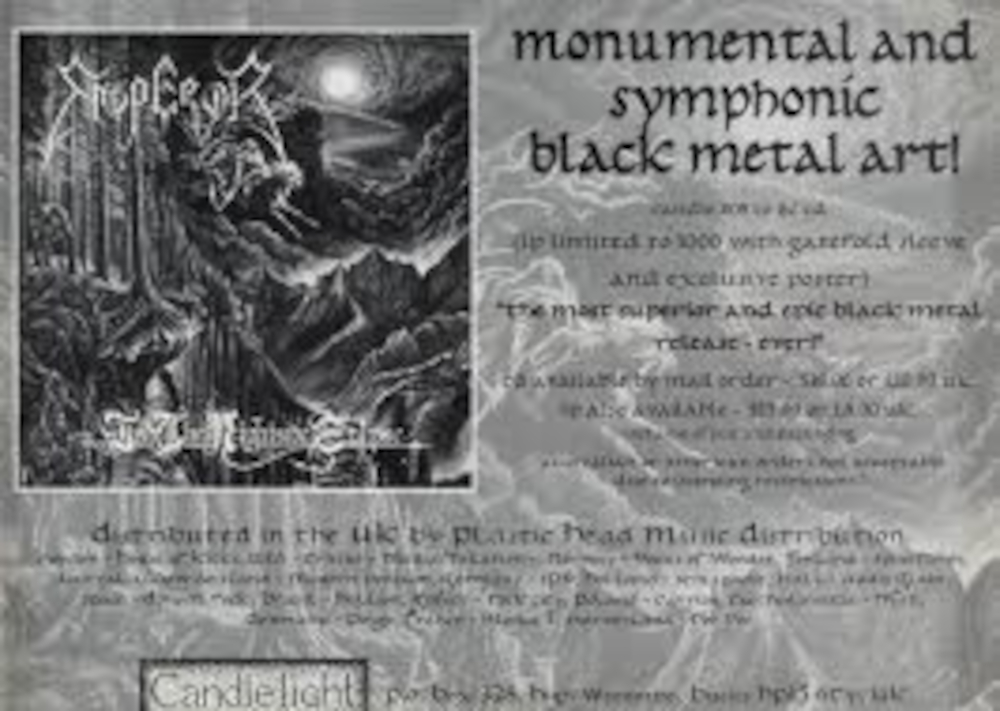
(Polish flyer)
Trivia
1) When Emperor recorded their debut album Ihsahn was only 17 and couldn't get into local pubs, so he spent the nights with Eirik Hundvin nicknamed Pytten, Grieghallen's studio engineer, learning about recording and studio technology.
2) Most keyboard parts were created in the studio as Emperor had never rehearsed with a keyboard player before.
3) Ihsahn was sick during the recording of the album and was spitting blood during the sessions. Some vocals were redone and some keyboards were added later on, and that contributed to the delay in the mixing.
4) Tchort was arrested for assault and vandalism. He stole a stone angel with blood covering it from a cemetery and placed it in his bedroom.
Samoth was arrested for various old Christian church burnings with Varg Vikernes and other members of the Black Circle in Norway.
Faust travelled to Lillehammer in '92 to visit his family. After attending a local pub, he went to an olympic park knowing it was a place where homosexuals used to meet. Fascinated with serial killers, he wanted to know what it fekt like killing someone with bare hands and accepted the sexual propostion by a gay man called Magne Andreassen. They walked into a nearby forest and Faust stabbed him 37 times with a knife he had with him, and after hearing he was still breathing, he then kicked and stomped on his head multiple times to be sure he was dead, so that he would not accuse him.
He was not convicted until 2 years later even if he spoke about it several times, even to Cradle of Filth's Dani during the '93 UK tour, but he was not believed, making Dani an involuntary accessory to the murderer.
After spending 9 years in prison, Faust stated that he had harboured hate and negativity for long, which consumed him from the inside. He obtained two bachelor degrees from the university of Oslo and expressed remorse for his actions, calling them senseless.
So far, the victim's family haven't expressed any will for revenge.
5) Samoth is a practicioner of Norse Paganism and claims he's never been a Satanist or an occultist, or a fascist.
6) Emperor disbanded because they thought they had a large catalogue, they had toured worldwide and didn't want to become one of those bands that don't know when to quit making music.
7) In Dec. '02 Ihsahn won the 'Notodden Kommunes Kulturpris', a culture prize given by his home city, Notodden, which has 12,500 inhabitants. He's the most well-known of them, as a musician of a band that sold over half a million copies, a music teacher and a concert organizer.
8) The album is dedicated to Mayhem's Euronymous, who died in '93 and introduced Emperor to Black Metal. If it hadn't been for him they would still be a Death Metal band as they were earlier when they went under the monicker Thou Shalt Suffer.
9) Mortiis was the first bass player for Emperor. He later formed his own eponymous band.
10) Emperor were signed to Deathlike Silence Productions, the first Black Metal label, but weren't able to release anything under that.
11) After the release of the debut album, Emperor stopped wearing corpse paint because it had become a trend.
12) Between '91 and '92 Samoth was the drummer for Emperor.
13) Ihsahn started learning to play the guitar playing along to Iron Maiden's "Seventh Son of A Seventh Son".
14) Faust worked at record store Helvete for some time.
15) In 2003, it was announced that Faust was going to be the drummer for Dissection at their reunion in 2004, but at the end of that same year Faust decided to leave the band, due to the ideology of the misanthropic Luciferian order that Jon Nödtveidt adopted at that time, which was not compatible with Faust.
16) Faust used to run the fanzine Orcustus.
17) The 20th anniversary of In the Nightside Eclipse was celebrated with a live performance of the full album at Wacken 2014 with Faust on drums.
18) Blood Music released a 25 LP boxed set containing all that Emperor have ever recorded including bonus tracks and rarities at 45 rpm!
19) Established in 1991, Emperor played their first gig on April 13th, 1992, along with fellow countrymen Algol, Enslaved and Infinite Decay.
20) Andrea Meyer Haugen, also known as Hagalaz' Runedance, was killed in the Kongsberg, Norway, attack on October 13, 2021. She was the ex-wife of Tomas "Samoth" Haugen from the black metal band Emperor. Meyer was one of five victims in an attack where a man armed with a bow and arrow killed them. Andrea Meyer Haugen (1969–2021) was a German musician, model, and writer who performed under various monikers, including Hagalaz' Runedance and Nebelhexë.
21) When Mortiis joined the band, Emperor just had 2 songs with no vocals or titles.He had the lyrics of "Forgotten Centuries" and "Moon over Kara-sher" lying around and came with the band's monicker and the logo. But the logo was sent to him by mail by an Eastern European guy, and Mortiis brought it to rehearsal. Emperor decided to keep it and Mortiis wrote that guy back even if he didn't know his name to thank him and inform him they would use it, but never heard anything from him anymore.
Lyrical content
The lyrics of the album were partly written by Ihsahn and Samoth, and
ex-member Mortiis. Mortiis wrote all the words for the 3 songs of the
EP "As the Shadows Rise".
They draw inspiration from mysticism, paganism, winter landscapes,
nature, "The
Lord of the Rings", Dracula and Transylvania, the Vikings and
anything ancient. Probably Ridley Scott's 1985 "Legend"
was also a visual and lyrical influence with its eternal winters
and goblins, as well as Tangerine Dream's soundtrack in its darkest
moments.
In the album the word 'Emperor' appears 4 times, once in 4 different
songs. It represents the band as en entity, Satan and the mighty.
Tchort didn't read the lyrics until he had a copy of the album as he
came from a different part of Norway and met the other guys only for
the rehearsals.
The topics treated in the album are the following:
* a creature awakening in northern Norway to bring darkness, sadness,
fear and warfare.
* a creature burning and crawling into silent shadows.
* old planets created by a dragon-clawed creature, one of which has
wolves and evil beings living in deep lakes.
* wolves howling surrounded by a vast forest and majestic mountains, as
well as resurrecting devils.
* an age of darkness rising again.
* a soul moving beyond to spend eternity with the night infernal
majesty.
* wizards collecting and feasting on souls imprisoned in hate.
* a hymn to forever-prevailing Satan.
The topics of the EP are:
* an ancient queen with black blood.
* a snake mastering the wind.
* an evil lord who has risen and burns towns.
Engineering and sound quality
Recorded in July '93, the album was mixed by Pytten only in '94 because half of the band was put in jail for some time and then the Grieghallen studio was booked for a while, so Emperor had to wait.
The EP was recorded at Studio S in December '92.
All tracks were remastered by Jens Bogren at Fascination Street Studios in 2014.
The production sees heavy use of reverb, and the synth and the piano parts make it really majestic and full of a morbid chilly vibe. Mind, this is not a Progressive Black Metal album, but a sophisticated royal orchestral kind of Black Metal.
The bass, which enjoys a good tone, is almost always easily discernible, whereas the drums sound a little muffled, rich in ghost-like blastbeats. Special care was taken to emphasize intricate and malevolent guitar patterns, either by dark lower notes or power chords played out of harmony, as well as melodic semi-leads and Ambient keyboard interludes.
Please note that "I Am the Black Wizards" and "Cosmic Keys to My Creations and Times" already appeared on the eponymous May 1993 EP, but thanks to Pytten's touch they have a better production here and are about half a minute shorter.
Track-by-track musical analysis
"Introduction" is a sulphureous prologue that seems to prepare the listener to enter the gates of hell or the arrival of the Antichrist on earth. Stately and rich in dark beats and really scary synth sounds, it delivers an unmatched feeling of anxiety.
Started by a rapid riff and drumming, a thunder clap, a reverberated synth and vampiresque screams, "Into the Infinity of Thoughts" sees the drumwork follow and later separate itself from the rest of the instruments by a sharp use of the splash cymbal before the initial blastbeat is repeated during the second verse. Then, a break driven by a synth and dynamic (almost Progressive) bass lines arrives. The Transylvanian vocals continue and become more persistent, while the synthwork grows more orchestral. It is now time for another riff with vulcanical synth sounds useful to modify the mood. Damned clean vocals and tribal drums precede the bloodsucker Black Metal chops reproposed here, ensued by glacial synth notes interposed.
The vocal parts turn into suffering cries, but there also exist clean ones before a brief instrumental part.
The described components present themselves again passing by one after the other until a riff sweeps everything away to give a gust of freshness: a freezing blastbeat is enriched by a long scream.
The structure met at the beginning returns, as well as a riff that stands out from the rest. And the synth reappears together with declamatory clean vocals prior to the last Black Metal assault of the song.
"The Burning Shadows of Silence" immediately commences halfway between Death and Black Metal thanks to rocky drumwork, but soon after it veers towards pure Symphonic Black Metal owing to a cursed intertwining of synth and drums.
Next, a lonely riff heralds a new furious acceleration anticipating a part where the vocals sound like clean recitations from a madman treated with some reverberation. This is followed by another interlocutory instrumental portion proceeding at mid speed bar the fast work at the drums. A vampire vibe comes to pass when the keys and the skrieks come before a memorable mid-tempo riff become a classic for many bands to imitate.
The riff that divides structures comes back along with intermiitent synth sounds and tight drumming, just a few instants before a breakneck verse with a blastbeat.
A hammering Thrash/Black Metal segment follows, and subsequently an instrumental Black Metal allocation with barely audible synth touches. Afterward, demonic Death/Black Metal vocals in the vein of Deicide and Vital Remains, and later on a section devoid of vocals ruled by the synth and the drums. There are few distant vocals later right before the conclusion which may remind us of some Gregorian chants.
The beautifully titled "Cosmic Keys to My Creation & Times" doesn't steer the vibes and patterns away from what we've heard so far until the closing minute arrives: first it assails us at maximum speed by stealth, then it recurs to a mid-paced riff, and the vocals become more and more coarse. Next, the composition touches the most traditional Symphonic Black Metal sonic shores, using blastbeats and elaborate drumwork. The guitars are placed far from the spotlight while the keys are going solo until the return of the low-mixed vocals. As is typical for Emperor, a mighty sudden riff upsets the atmosphere, till an oneiric instrumental piece arrives. A few usual possessed screams befall, supervened by a mammoth blastbeat and a speedy agile rhythm later on.
Faust gets busy with accurate cymbal work and snare drum work up to us listeners are struck by a celestial twin riff of guitar and synth before falling into an infernal abyss one more time, rife with numerous wicked far-flung vocals.
And this is when the number reaches its apex of originality, absurdity and derangement: the vocals become the emblem of suffering and the musical stratum radically changes, this time drawing inspiration from Celtic Frost, which Black Metal vocals are added onto. The mid tempo is merciless and crushing, and the vocals caw giving the final blow as far away as the point when the song is concluded by raspy vocals.
A royally fiendish mid-tempo riff starts "Beyond the Great Vast Forest", soon embellished by an icy timing change, in turn followed by a riff with a controlled blastbeat and then accurate drum fills. The tune is interrupted by a warrior-like riff that goes on while the drumming blastbeats at full speed. And here come the finest Black Metal vocal chops of the whole album! After them the mid tempo pops in again, whose foundations are elegant, orchestral, deep synth touches, while the drums emphasize the mood along with windy bass lines. Then, a slight speed-up carries on the advance of the musical death machine going by the name of Emperor without a hinch.
What is being done at the synth becomes even more delightful, and so does the way the drums keep the pace. But there is an instant when they modify the thyrthm by reproposing the bellicose Punkish bit.
The last minute is abundant with variations despite the repeated riff, thanks to all that the other instruments play, especially the layers of vocals that reach unparalleled levels of torture and affliction while the music fades out.
I don't understand why some people say "Towards the Pantheon" could have been left out of the full-length track list as I believe it has all the right to be in there. It is a tad different, but this is one further reason to keep it on the album and make the record more various and entertaining.
A synth and guitar arpeggio open the track bringing us to a place where a faint sun ray enters, yet shortly we are kicked back down. We crash onto the bottom of hell when rotten haunted screams materialize.
The riff conveys an unsual sense, ensued by another closer to a soundtrack announcing a war is about to break out. The riff and the synth continue, defining what Symphonic Black Metal is once and for all.
Afterwards, an instrumental part is interjected by means of penetrating synth touches and vocals increasing their aggressiveness. The guitar has itself heard through the most convoluted riff of the entire platter, just before the reinstated intertwisting of keyboard, vocals and drums. The rhapsody moves forward by adopting the most cruel fashion of Black Metal, until vaguely dreamy keyboards in the finalè that accompany us until the faded out end.
"The Majesty of the Nightsky" immediately jumps at your throat to strangle you with an alternation of a blastbeat session and a less fast tempo with the usual sharpness the Norwegian band have accustomed us to, encarved by Viking riffs also a little Bathory-influenced leaving a strong mark on the song, and I refer to epic sections reminding us of their fourth full-length "Blood, Fire Death".
Ritual drumming precedes a new burst of vain excellent synth lines. The vocals in the background accompany several guitar licks, until a polar and fairy synth work all of a sudden transforms the feel completely under the aegis of a delicate mid tempo combined with gusts of wind. Clean vocals declaim and utter with a grave tone, halted only by a guitar lick which is placed upon the remaining elements. A variation leads us to a short definitive strike in which the vocals give the impression of a very wild cat fighting tooth and nail against another to protect one's territory. The closure is realized through the medium of an explosion louder than a Tsar Bomb, that makes all the listener's surroundings shake.
Additional pounding perpetrated by a horde of demons exited from the underworld, "I Am the Black Wizards" dissipates any doubt about who the prince of this world is.
A soulless riff is reiterated till the otherworldly rift equipped by typical cawing vocals, which other more forceful are adjoined to in anticipation of a blast beat spicied with symphonious synths. A riff is rerun in order to function as an accompaniment of the synthesizer, which resurfaces by a familiar reverberated synth sprung out from another dimension.
The opus goes through an abyssal split on the path of Darkthrone or Mayhem, and therefore an original riff lands, to then die in the notes of persistent guitar squealing. A few seconds elapse and we are in front of more vocals coming from a body occupied by a demon, then there is time for a melodic Doom/Black Metal part supplemented by screams, and then clean declaiming vocals, and finally both of the vocals together.
One of the reasons why a Black Metal beginner should start their musical learning process through this song is the stout usage of tremolo picking riffs and Ihsahn's vocals, so similar to a phantom or banshee, or in other instances, a person whose soul is possessed. Thirdly, the synth is employed like a violin in some classical music arias. These are some of the basic trademarks of the genre.
Particularly ear-catching and appealing is the work full of fills behind the drum kit by Faust at the start of "Inno A Satana", in partnership with a riff different than the previous ones. This masterpiece proceeds through a blend of clean Viking vocals and conventional accursed ones for some time in expectation of the moment when the drums get frozen for a while. Then they restart in an odd signature while the guitarist crafts Progressive licks.
The shrieks come again not for long, followed by alternated or blent Viking vocals. Then, a new fracture is created by damnable synth sounds before the last spiteful blastbeat, even if the synth lines are almost heavenly, or at least fairy.
The Viking vocals stand out on multiple layers combined with Black Metal wails. Afterwards, a heavy sigh and only the keyboards remain to finish the track alone.
The bonus tracks are 3 and compose the rare and limited 7" EP "As the Shadows Rise", where the sound engineering is inferior and rawer, with the classical morbid mosquito-like guitars.
The first song is "The Ancient Queen", made of Symphonic Black Metal incorporating Viking synth and guitar riffs.
The keys refer to Transylvanian folklore once again matched with blastbeats till the massive initial riff shows itself one more time.
Another riff is instead advantageous to crack open two dissimilar rhythms and prepare for an icy mid tempo. Coming up are keys that go on lonely to the conclusion.
"Witches Sabbath" is inaugurated by a riff evoking old Celtic Frost memories, along with hysterical vocals, then a mid tempo with the synth as protagonist. Later on we meet a break with tribal drums, choked vocals in the background, ogrish vocals, and even a mid tempo with a semi-distorted guitar triggering Darkthrone recollections so as to put the listener into the right mood for damned vocals.
A disruption in a Progressive Death Metal mid tempo ensues, decorated by wonderful freezing howls.
A Viking Metal slice runs to us, followed by a riff that rapidly messes everything up leading to a somewhat Punk incursion.
Delirium takes over Ihsahn's voice, then he turns into a monster, whilst the Celtic Frost-inspired riff continues to be truncated soon again. The guitar dedicates itself to a funeral riff, paired with sad and solemn vocalisations resulting in a corrosive final speed increase abruptly terminated.
Compared to the other EP and album tracks, "Lord of the Storms" is a brief composition. Begun by a riff homaging Venom, a speed-up that Hellhammer fans are going to adore, it is a really captivating melody cut only by the reproposition of the opening above-mentioned riff with cantankerous high pitched throat sounds. Other yells, even coarser and subjected to reverb emerge just before demonic Death Metal vocals at the end.
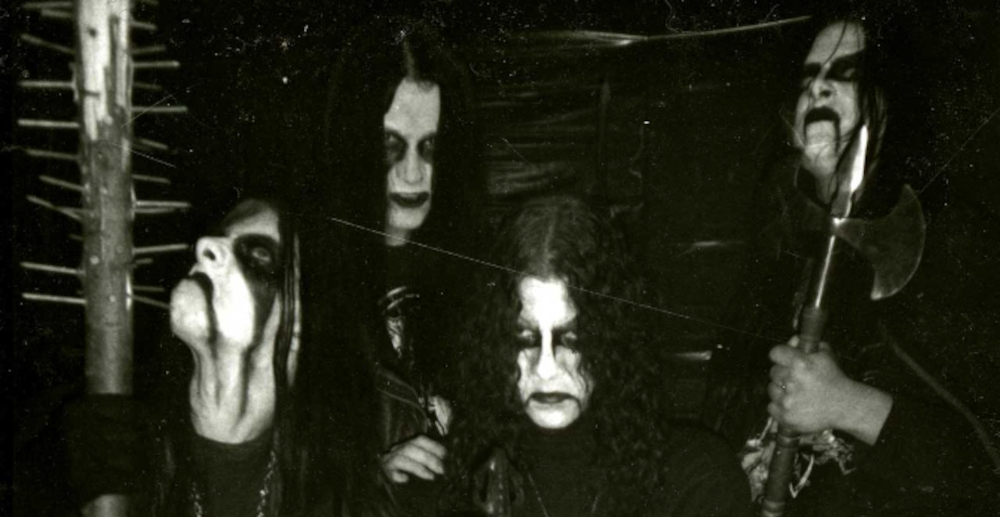
Value
The value of this release is huge for the history of the second wave of
Black Metal and this version is a good compromise if you missed the 7
EP like me, otherwise stick to your original pressing or alternatively
to the 1999 re-release by Century Black records with 2 cover versions
as bonus tracks, respectively "A Fine
Day to Die" by Bathory and "Gypsy"
by Mercyful Fate.
Conclusion
On this album every aspect was thought out carefully, and best of all, Emperor's debut is something more than just a collection of songs. This isn't one of those records you put on your phone and pick one song to listen repeatedly. No, it's an album best heard in its entirety, front to back. The full 50 minutes captures an atmosphere so unique, even Emperor themselves couldn't replicate it or top it later.
A matchless document of total darkness.
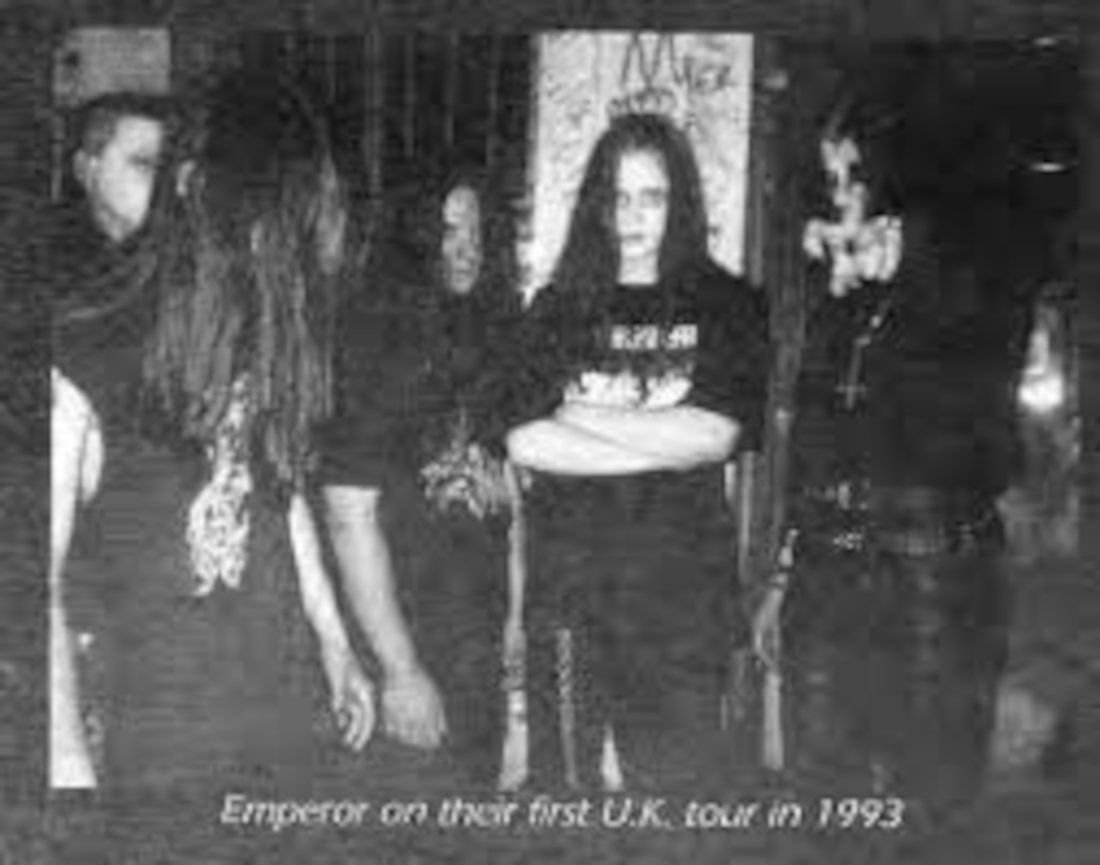
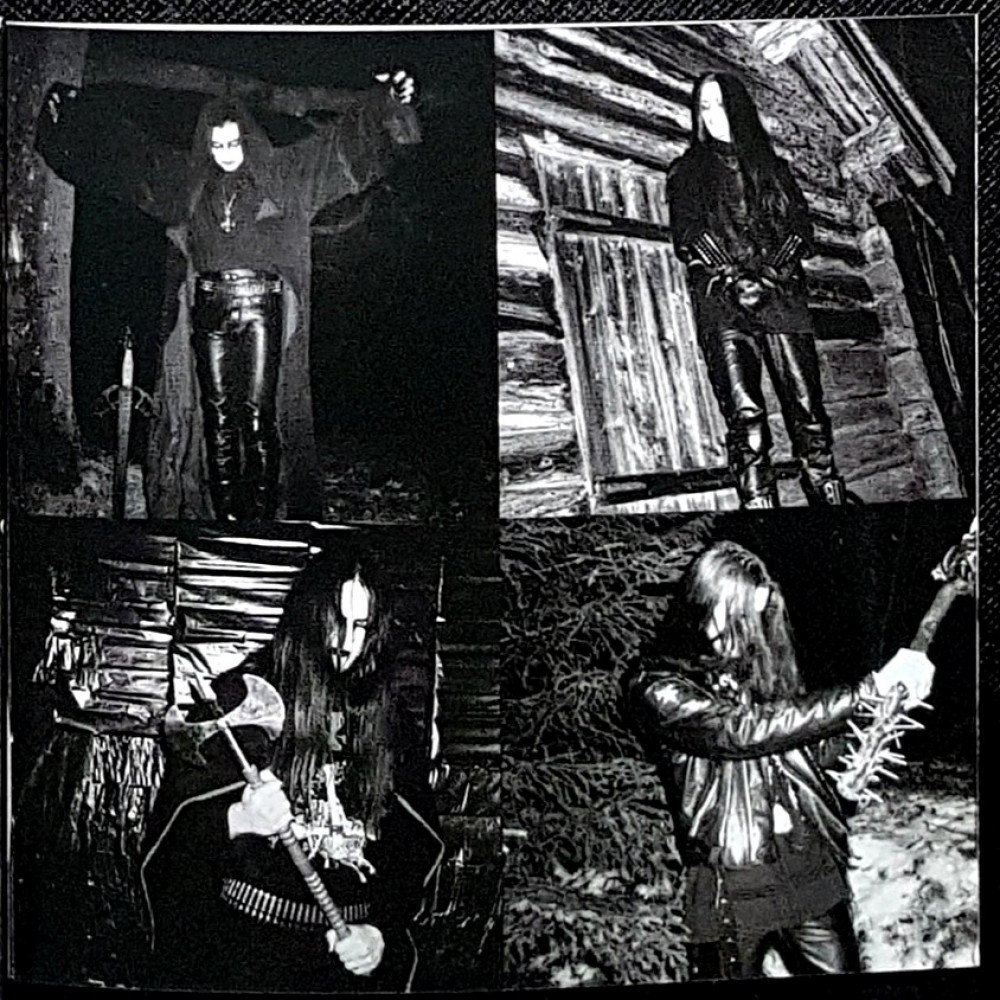
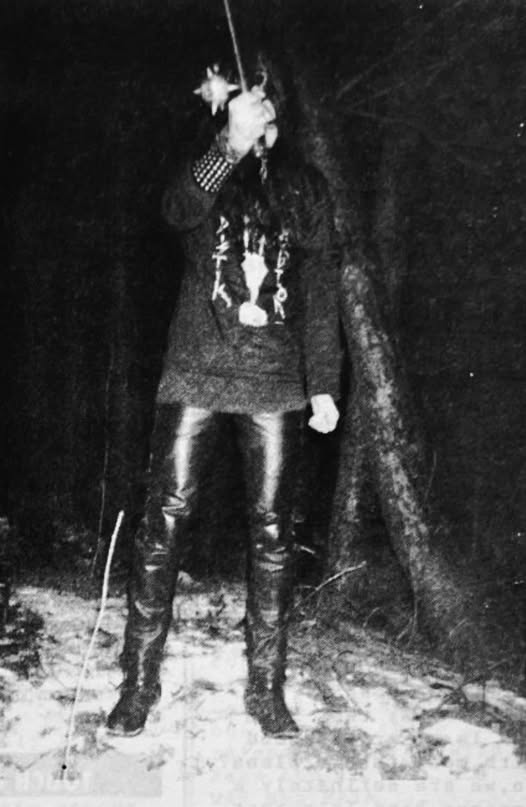
Tracklist:
1. Introduction
2. Into the Infinity of Thoughts
3. The Burning Shadows of Silence
4. Cosmic Keys to My Creations and Times
5. Beyond the Great Vast Forest
6. Towards the Pantheon
7. The Majesty of the Nightsky
8. I Am the Black Wizards
9. Inno A Satana
Bonus tracks:
10. The Ancient Queen
11. Witches Sabbath
12. Lord of the Storms
Discography:
-Wrath of the Tyrant (demo - 1992)
-Emperor (EP - 1993)
-Emperor/Hordanes Land (split - 1993)
-In the Nightside Eclipse (full-length - 1994)
-As the Shadows Rise (EP - 1994)
-Reverence (EP - 1997)
-Anthems to the Welkin at Dusk (full-length - 1997)
-Emperor/Wrath of the Tyrant (compilation - 1998)
-Century Media Spring/Summer 1999 Sampler (split - 1999)
-IX Equilibrium (full-length - 1999)
-Thorns vs. Emperor (split - 1999)
-True Kings of Norway (split - 2000)
-Emperial Live Ceremony (live album - 2000)
-Emperial Live Ceremony (video - 2000)
-The Emperial Live Prsenetation (boxed set - 2001)
-Prometheus - The Disciple of Fire and Demise (full-length - 2001)
-Candlelight Collection Vol. 5 (split - 2002)
-Scattered Ashes: A Decade of Emperial Wrath (compilation - 2003)
-Thus Spoke the Nightspirit/Inno A Satana (single - 2009)
-Live at Wacken Open Air 2006 - A Night of Emperial Wrath (live album -
2009)
-Live Inferno (live album - 2009)
-Live at Wacken Open Air 2006 - A Night of Emperial Wrath (video - 2009)
-Live Inferno (boxed set - 2009)
-The Complete Works (boxed set - 2017)
-Fire & Demise - Into the Infinity of Darkness (boxed set - 2022)
-Rehearsal '92 (tape - 2022)
-Rehearsal 1992 (7" - 2025)
Line-up on this album:
Ihsahn - v., g., k., songwriting, lyrics (ex-Embryonic, ex-Hardingrock,
ex-Peccatum, ex-Revolution harmony, ex-Thou Shalt Suffer, ex-Xerasia,
ex-Zyklon-B, ex-God of Atheists, also in
Ihsahn, guest session in Arcturus, Devin Townsend Project, Ibaraki,
Ildjarn, Jeff Loomis, Leprous, Orkenkjott, Trivium, Ulver, Wongraven)
Samoth - g., songwriting (ex-Arcturus, ex-Conspiracy, ex-Embryonic,
ex-Fast Breeder, ex-Gorgoroth, ex-Notodden All Stars, ex-Satyricon,
ex-Spina Bifida, ex-Thou Shalt Suffer, ex-Xerasia, ex-Zyklon,
ex-Zyklon-B, ex-Zyltelab, also in Scum, The Wretched End)
Tchort - b. (ex-Blood Red Throne, ex-Carpathian Forest, also in Green
Carnation, The 3rd Attempt)
Faust - d. (ex-Aborym, ex-Bomberos, ex-Decomposed Cunt, ex-Stigma
Diabolicum, ex-Thorns, also in Blood Fire Death, Blood Tsunami, Djevel,
Galgeberg,
Scum)
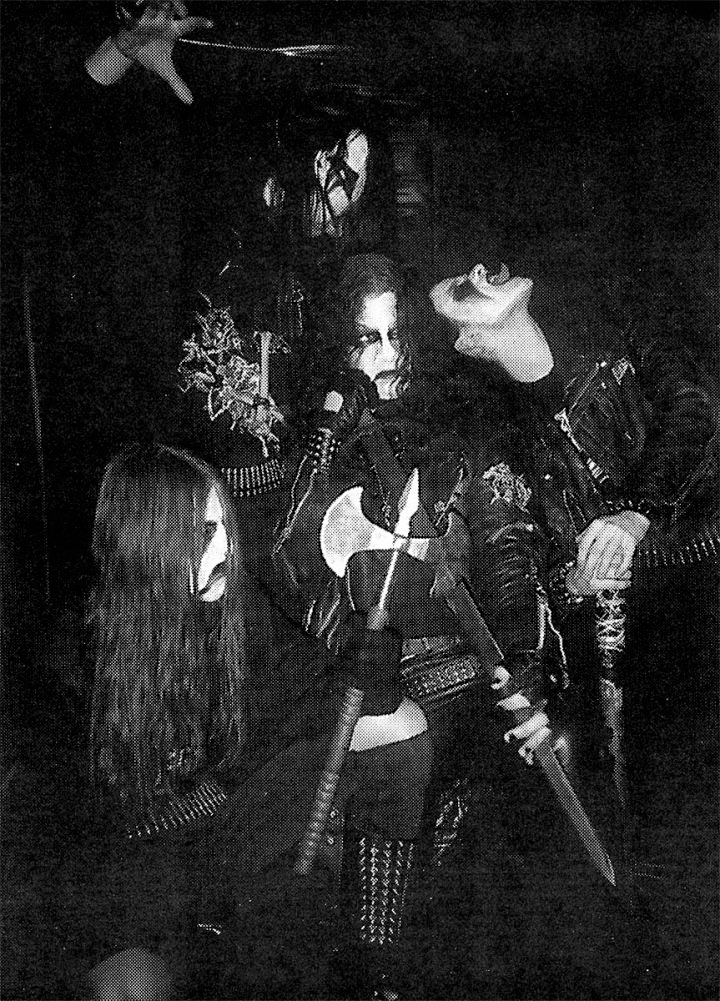
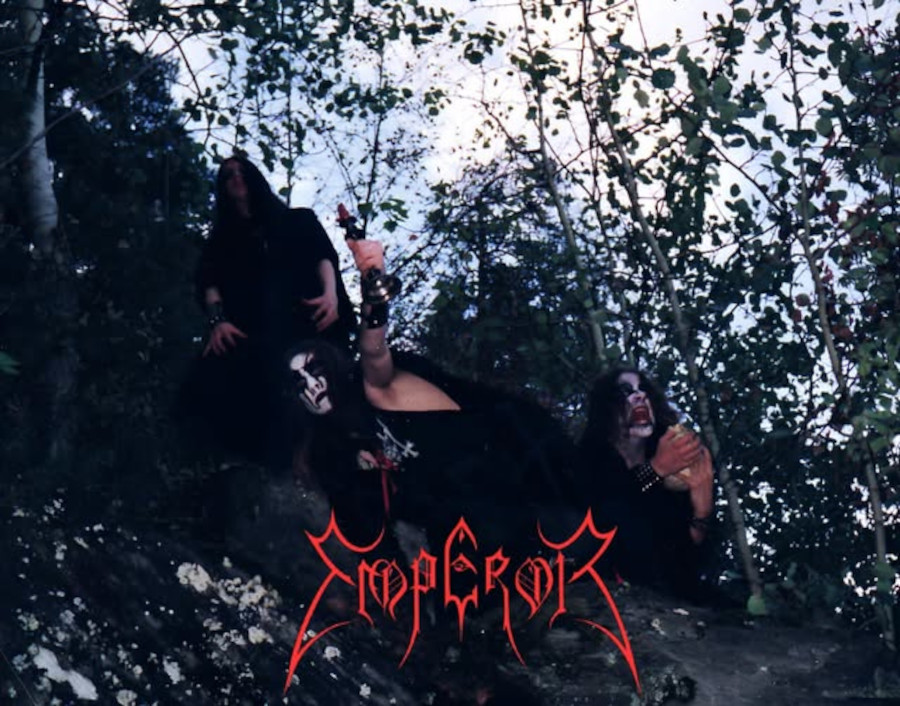
Contacts:
Notodden, Telemark - Norway
E-mail: grave@photograve.net
Official website homepage:
http://www.emperorhorde.com/
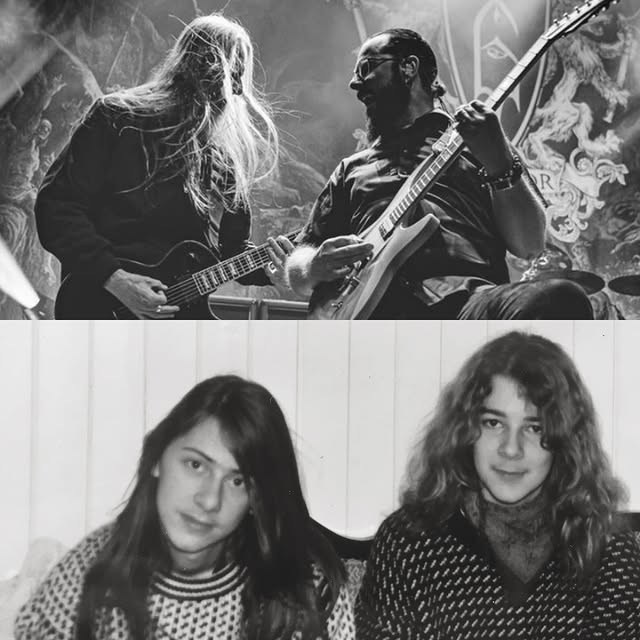
(Samoth and Ihsahn)
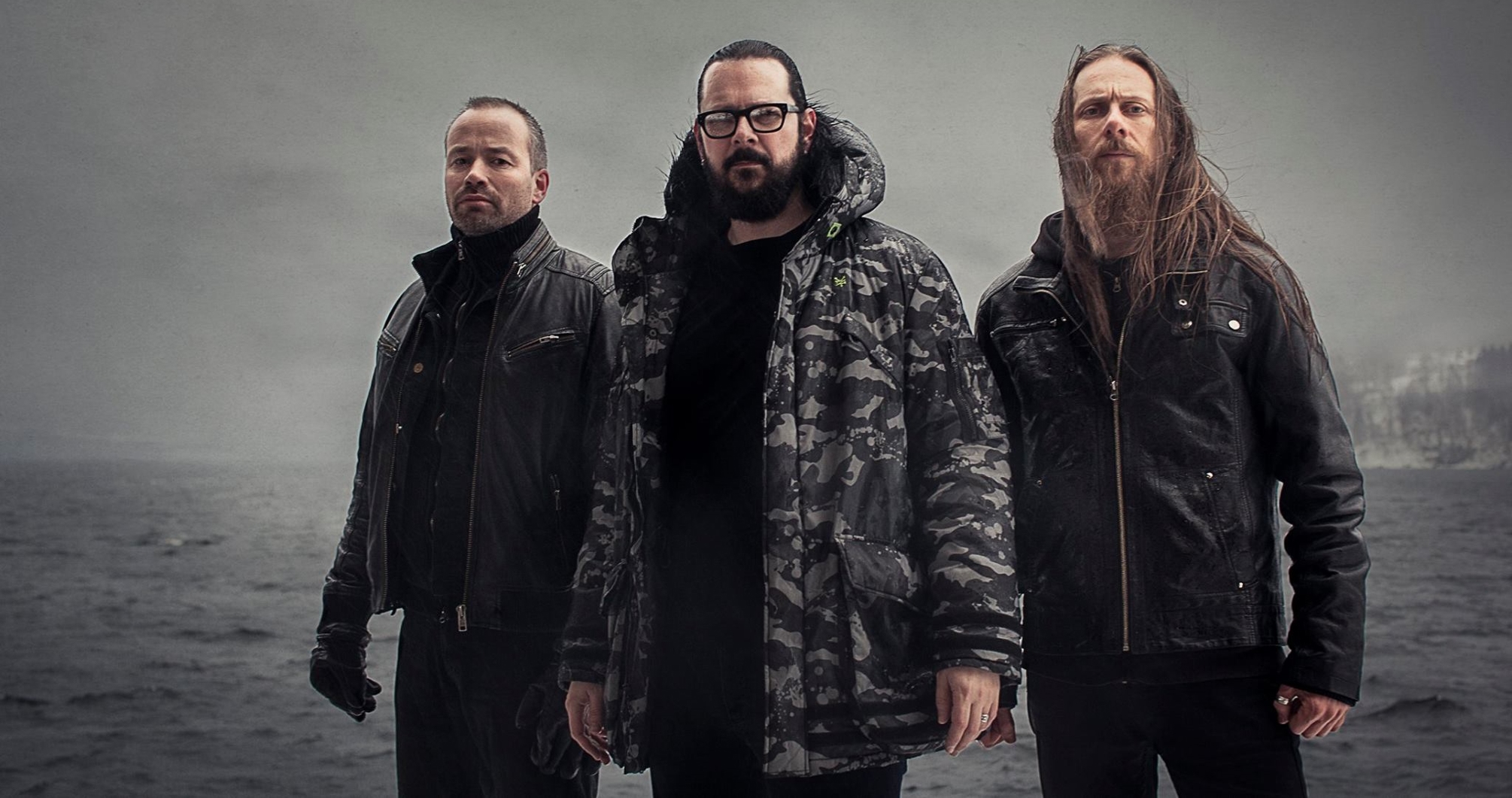
(Emperor
today - 2025)
Official main links:
Facebook
Spotify
Instagram
Qobuz
Tidal
Deezer
DON'T MISS THIS ALBUM'S VIDEO REVIEWS IN ENGLISH AND
ITALIAN:
English video review:
https://youtu.be/2aAhAyH9g1A
Italian video review:
https://youtu.be/pfhuCrYdqjU
